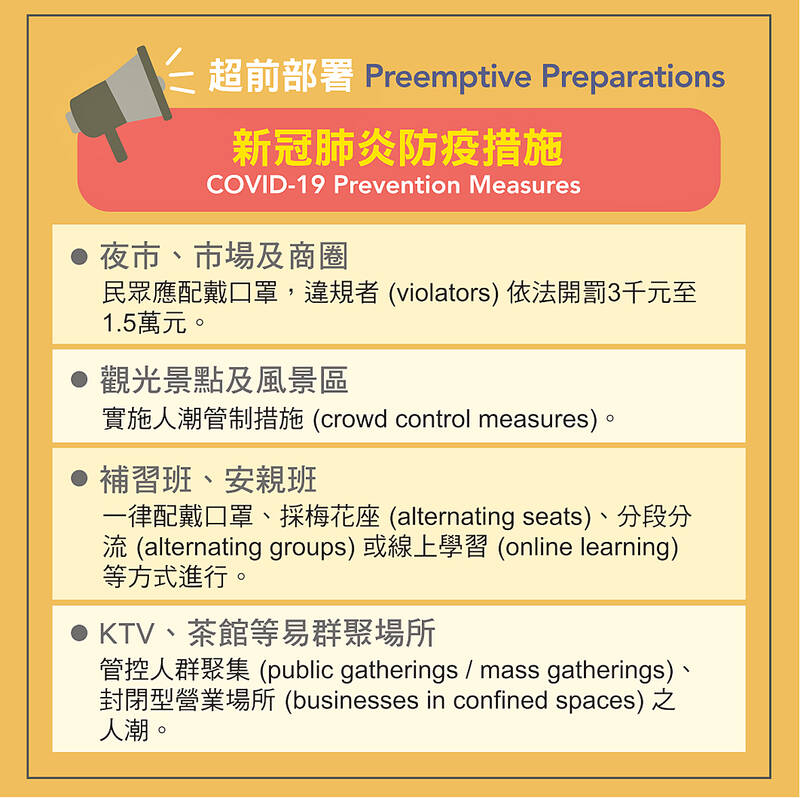在防疫期間,「超前部署」此一用語常見諸報章,成為台灣很夯的熱詞 (buzzword):
超前部署並非2020 年才出現的用語,以下為一些過去台灣政府官員曾使用「超前部署」的語境:
總統馬英九今天指出,八八風災帶來很大教訓,應落實災害防救工作……料敵從寬,禦敵從嚴,超前部署……2010 年 5 月 26 日,《中央社》

Photo/Graphic courtesy of Bookman l 圖片:書林
行政院副院長張善政……表示,蓮花颱風速度雖然減緩……料敵從嚴,並以超前部署為原則……2015 年 7 月 7 日,《新聞傳播處》
《今日科學》有篇文章 “Outbreak science: Infectious disease research leads to outbreak predictions” 就提到做好預判,有利政府防疫的「超前部署」:
Infectious disease outbreaks, whether they be widespread like Influenza or fairly geographically restricted like Ebola, may be difficult to prevent . . . if we can forecast outbreak potential in time, public health officials and governments can preemptively prepare for a potential outbreak event.
傳染病爆發,無論是像流感那樣全面,或像伊波拉那種侷限某些地理區域,都很難預防— 然而,如果我們可以及時預知(疾病)爆發的可能,公衛當局和政府便可以為潛在的疫情爆發提前部署。
Science Daily, January 8, 2020
所以「超前部署」若是在「防災/防疫」的語境下,可譯為preemptive preparation 或 preemptive preparedness,如果用作動詞,可以說 preemptively prepare for (an outbreak, etc.)。
《世界雜誌》上有位作者提到 preemptive 和 preparation 的差異,她說 preemptive 的弦外之音是 heading off something undesirable(避凶/避災):
“Preemptive” and “preparation” both refer to work done ahead of time in order to be ready for something that will or may come. “Preemptive” carries the additional sense of heading off something undesirable. One “prepares” for a camping trip; one “preempts”the flu by getting a vaccination.
“Preemptive preparation” by Andree Seu Peterson, World, March 7, 2014
當然「超前部署」英文也可以有別的表達方式,如:plan(ning) way in advance, plan(ning) way ahead of time 等。若使用 Google search,會發現不同的用法都有一定的使用比例。
不過 plan(ning) way in advance 及 plan(ning) way ahead of time 比較常用在為結婚、度假、活動、事業發展提早做準備,不像 preemptive preparation,有為「避災/避凶」而提前做好應變計畫 (contingency plan) 的意味。
由於新冠疫情,「超前部署」這一時髦詞彙,已成為流行語,用於比較輕鬆的場合,甚至廣告文案、行銷上。某個學會的理監事會上,承辦下一屆研討會的學校代表報告籌備進度,因為那研討會一年半後才要召開,有老師就開玩笑說:「真是超前部署!」在這種情境下「超前部署」就不宜譯為 preemptive preparation,而是 plan(ning) way in advance 及 plan(ning) way ahead of time 更合適了。
防疫必備詞彙:新聞熱詞
熱詞 buzzword
超前部署 preemptive preparation; preemptive preparedness
撤僑專機 citizen evacuation flight
類包機 semi-charter flight
普篩 widespread screening/testing (for COVID-19)
75%酒精 75% alcohol disinfectant
漂白水 bleach
次氯酸水 hypochlorous acid water; hypochlorous acid disinfectant
文章由書林出版公司提供:
www.bookman.com.tw
蘇正隆 — 台灣翻譯學學會前理事長、師大翻譯研究所兼任副教授; 編著《英語的對與錯》,《世紀病毒:必讀防疫英文知識與詞彙》...等

In an effort to fight phone scams, British mobile phone company O2 has introduced Daisy, an AI designed to engage phone con artists in time-wasting conversations. Daisy is portrayed as a kindly British granny, exploiting scammers’ tendency to target the elderly. Her voice, based on a real grandmother’s for authenticity, adds to her credibility in the role. “O2” has distributed several dedicated phone numbers online to direct scammers to Daisy instead of actual customers. When Daisy receives a call, she translates the scammers’ spoken words into text and then responds to them accordingly through a text-to-speech system. Remarkably, Daisy

Bilingual Story is a fictionalized account. 雙語故事部分內容純屬虛構。 Emma had reviewed 41 resumes that morning. While the ATS screened out 288 unqualified, she screened for AI slop. She could spot it a mile away. She muttered AI buzzwords like curses under her breath. “Team player.” “Results-driven.” “Stakeholder alignment.” “Leveraging core competencies.” Each resume reeked of AI modeling: a cemetery of cliches, tombstones of personality. AI wasn’t just changing hiring. It was draining the humanity from it. Then she found it: a plain PDF cover letter. No template. No design flourishes. The first line read: “I once tried to automate my

Every May 1, Hawaii comes alive with Lei Day, a festival celebrating the rich culture and spirit of the islands. Initiated in 1927 by the poet Don Blanding, Lei Day began as a tribute to the Hawaiian custom of making and wearing leis. The idea was quickly adopted and officially recognized as a holiday in 1929, and leis have since become a symbol of local pride and cultural preservation. In Hawaiian culture, leis are more than decorative garlands made from flowers, shells or feathers. For Hawaiians, giving a lei is as natural as saying “aloha.” It shows love and

1. 他走出門,左右看一下,就過了馬路。 ˇ He walked outside, looked left and right, and crossed the road. χ He walked outside and looked left and right, crossed the road. 註︰並列連接詞 and 在這句中連接三個述語。一般的結構是 x, y, and z。x and y and z 是加強語氣的結構,x and y, z 則不可以。 2. 他們知道自己的弱點以及如何趕上其他競爭者。 ˇ They saw where their weak points lay and how they could catch up with the other competitors. χ They saw where their weak points lay and how to catch up with the other competitors. 註:and 一般連接同等成分,結構相等的單詞、片語或子句。誤句中 and 的前面是子句,後面是不定詞片語,不能用 and 連接,必須把不定詞片語改為子句,and 前後的結構才相等。 3. 她坐上計程車,直接到機場。 ˇ She took a cab, which took her straight to the airport. ˇ She took a cab and it took her straight